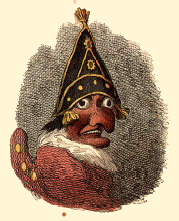But many also describe the world surrounding the Empire. Lately the renowned lute player and folk singer Christoph Von Kleinestadt has gained popularity performing his song “The Estalian Coach” at various venues in our capital. I have heard it many times during my outings to The Burning Table, and have taken the liberty of scribing the text to preserve it for those who come after me.
As my observant reader will notice, Von Kleinestadt brings together current events in Altdorf (see my short text on Heartless Jochen) as well as the sinister symbolics of Old World rural folk lore (The Great Jester mentioned in my writings on Gaspar und Gretchen makes an appearance). Wrapped up in this ditty is also a theological conundrum; is it possible that the gods are playing games with their followers, and that our very souls can be staked in a game of chance? Needless to say, the Church of Morr is not amused by the lyrics. Also note the use of the card game Pochen as a symbolic battle between the forces of Chaos and the Lord of Death.
There’s an Estalian coach that runs between
Gualcasar and Bilbali.
In the dead of night the bugle blows,
And people hear,
she’s running still.
And then they hush their children back to sleep,
lock the doors, upstairs they creep.
For it is said that the souls of the dead,
fill that coach –
ten thousand deep!
Well a coaching man lay dying,
with his people by his side.
His family were crying,
knelt in prayer before he died.
But above his bed
just a-waiting for the dead,
was the Jester with a twinkle in his eye.
– Well Morr’s not around,
and look what I’ve found,
This one’s mine!
Just then the Lord of Death appeared
in a blinding flash of light.
And shouted at the Jester
– Get thee hence to endless night!
But the Jester just grinned,
and said, – I may have sinned,
but there’s no need to push me around.
– I got him first
so you can do your worst,
He’s going underground!
– But I think I’ll give you one more chance,
said the Jester with a smile.
– So throw away that stupid lance,
It’s really not your style.
– Jochen is the name, Pochen is the game,
we’ll play right here on his bed!
And then we’ll bet for the bigger stakes yet;
The souls of the dead!
And I said,
– Look out, Lord, He’s gonna win,
The sun is down and the night’s riding in.
That coach is dead on time,
many souls are on the line,
Oh, Lord he’s gonna win!
Well the coaching man he cut the cards,
and he dealt them each a hand of five.
And for the Lord he was praying hard,
for that coach he’d have to drive…
Well, the Jester he had three aces and king.
And Morr, He was running for a straight.
He had the queen and the knave
and a nine and ten of spades,
All He needed was the eight…
And then Morr he called for one more card,
But He drew the diamond eight,
And the Jester said to the Lord of Death,
– I believe you’ve got it straight.
– So deal me one,
for the time has come to see
who’ll be the king of this place.
But as he spoke, from beneath his cloak,
He slipped another ace…
Ten thousand souls was the opening bid,
Soon went up to fifty-nine.
But Morr did not see what the Jester did,
And said, – That suits me fine.
I’ll raise you high, to a hundred and five,
and forever put an end to your sins!
But the Jester let out a mighty shout,
– My hand wins!
And I said, – Lord, oh Lord, you’ve let him win,
The sun is down and the night is riding in.
That coach is dead on time,
many souls are on the line,
Oh Lord don’t let him win…
Well that Estalian coach still runs between,
Gualcasar and Zaraguz,
In the dead of night the bugle blows,
and people fear,
she’s running still…
And far away in some recess,
Morr and the jester are now playing chess.
The jester still cheats and wins more souls,
And as for Lord Morr,
well, He’s just doing his best….
And I said,
– Lord, oh Lord, you’ve got to win,
The sun is down and the night is riding in.
That coach is still on time,
oh my soul is on the line…
Oh Lord, you’ve got to win…
Adolphus Altdorfer
Marktag, Pflugzeit 24, 2522 IC
According to Wikipedia, “Pochen” could be the root of the name for the card game we today know as “Poker”.
With thanks and sincere apologies to Chris De Burgh, who wrote the song Spanish Train, upon which The Estalian Coach is based.
Magnus


